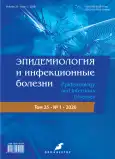Meningoencephalitis case with listeriosis etiology in an immunocompetent female patient
- Authors: Domashenko O.N.1, Gridasov V.A.1
-
Affiliations:
- M. Gorki Donetsk national medical university
- Issue: Vol 25, No 1 (2020)
- Pages: 41-44
- Section: CASE REPORTS
- URL: https://journals.rcsi.science/1560-9529/article/view/35183
- DOI: https://doi.org/10.17816/EID35183
- ID: 35183
Cite item
Full Text
Abstract
Nervous forms of listeriosis are observed in 5%–10% of persons suffering from this disease and in 75% of children with bacteriologically confirmed listeriosis as well. The most widespread clinical variant is Listeria meningitis, making up 15% of all cases of bacterial and serous meningitides. The mortality rate at neurolisteriosis reaches 30%–40%. A case of acute meningoencephalitis associated with Listeria monocytogenes 4b in a 37-year-old immunocompetent woman is described. The disease was characterized by subacute onset, manifested intoxication, long-lasting and high-grade fever, cerebral coma, bulbar syndrome, right-side hemiparesis, bilateral hypertonus of the wrist flexors, strabism, anisocoria, manifested leukocytosis with leukocyte formula stab shift, ESR 45–59 mm/hour. Cerebrospinal fluid test: cytosis – 663 сells in 1 mcl, neutrophils – 79%, lymphocytes – 21%, protein – 1451 mg/l, glucose – 3.8 mmol/l. Diagnosis had been confirmed with detection of IgM against Listeria monocytogenes 4b in liquor using the indirect immunofluorescence reaction and Listeria monocytogenes by means of PCR. Antibacterial therapy had been conducted using Meropenem, Ampicillinum, endolumbal administration of 4 mg once daily of Gentamycinum combined with intravenous administration of 24 million of units/day of Penicillin. On day 50, she was transferred for rehabilitation treatment to the Department of Neurology.
Keywords
Full Text
##article.viewOnOriginalSite##About the authors
Olga N. Domashenko
M. Gorki Donetsk national medical university
Author for correspondence.
Email: o_domashenko@mail.ru
ORCID iD: 0000-0002-0517-3141
SPIN-code: 7621-8255
MD, PhD, Professor
DonetskVitaliy A. Gridasov
M. Gorki Donetsk national medical university
Email: gridasov_doc@mail.ru
ORCID iD: 0000-0002-1844-4043
MD
DonetskReferences
- Silk BJ, Date KA, Jackson KA, et al. Invasive listeriosis in the Foodborne Diseases Active Surveillance Network (FoodNet), 2004–2009: further targeted prevention needed for higher-risk groups. Clin. Infect Dis. 2012;54(Suppl. 5):S396–404. doi: 10.1093/cid/cis268.
- Noordhout CM, Devleesschauwer B, Angulo FJ, et al. The global burden of listeriosis: a systematic review and meta-analysis. Lancet Infect Dis. 2014;14(11):1073–82. doi: 10.1016/S1473-3099(14)70870-9.
- Swaminathan B, Gerner-Smidt P. The epidemiology of human listeriosis. Microbes Infect. 2007;9(10):1236–43. doi: 10.1016/j.micinf.2007.05.011.
- Wing EG, Gregory SH. Listeria monocytogenes: clinical and experimental update. J. Inf. Dis. 2002;185(Suppl. 1):18–24. doi: 10.1086/338465.
- Erdem H, Inan A, Guven E, et al. The burden and epidemiology of community-acquired central nervous system infections: a multinational study. Eur J. Clin. Microbiol. Infect. Dis. 2017;36(9):1595-611. doi: 10.1007/s10096-017-2973-0.
- Domashenko ON, Gridasov VA. Neurological lesions in listeriosis. In: Materials of the X Annual All-Russian Congress on Infectious Diseases with international participation [Materialy Х Ezhegodnogo Vserossijskogo Kongressa po infektsionnym boleznyam s mezhdunarodnym uchastiem]. Moscow; 2018:65. (in Russian)
- Khan S, Kumar A, Kale S, et al. Multiple cortical brain abscesses due to Listeria monocytogenes in an immunocompetent patient. Trop Doct. 2018;48(2):160–3. doi: 10.1177/0049475517728670.
- Yushchuk ND, Karetkina GN, Dekonenko EP, et al. Listeriosis with affection of the nervous system. Terapevticheskiy arkhiv. 2007;79(11):57–9. (in Russian)
- Thønnings S, Knudsen JD, Schønheyder HC, et al. Antibiotic treatment and morality in patients with Listeria monocytogenes meningitis or bacteraemia. Clin. Microbiol. Infect. 2016;22(8):725-30. doi: 10.1016/j.cmi.2016.06.006.
Supplementary files






